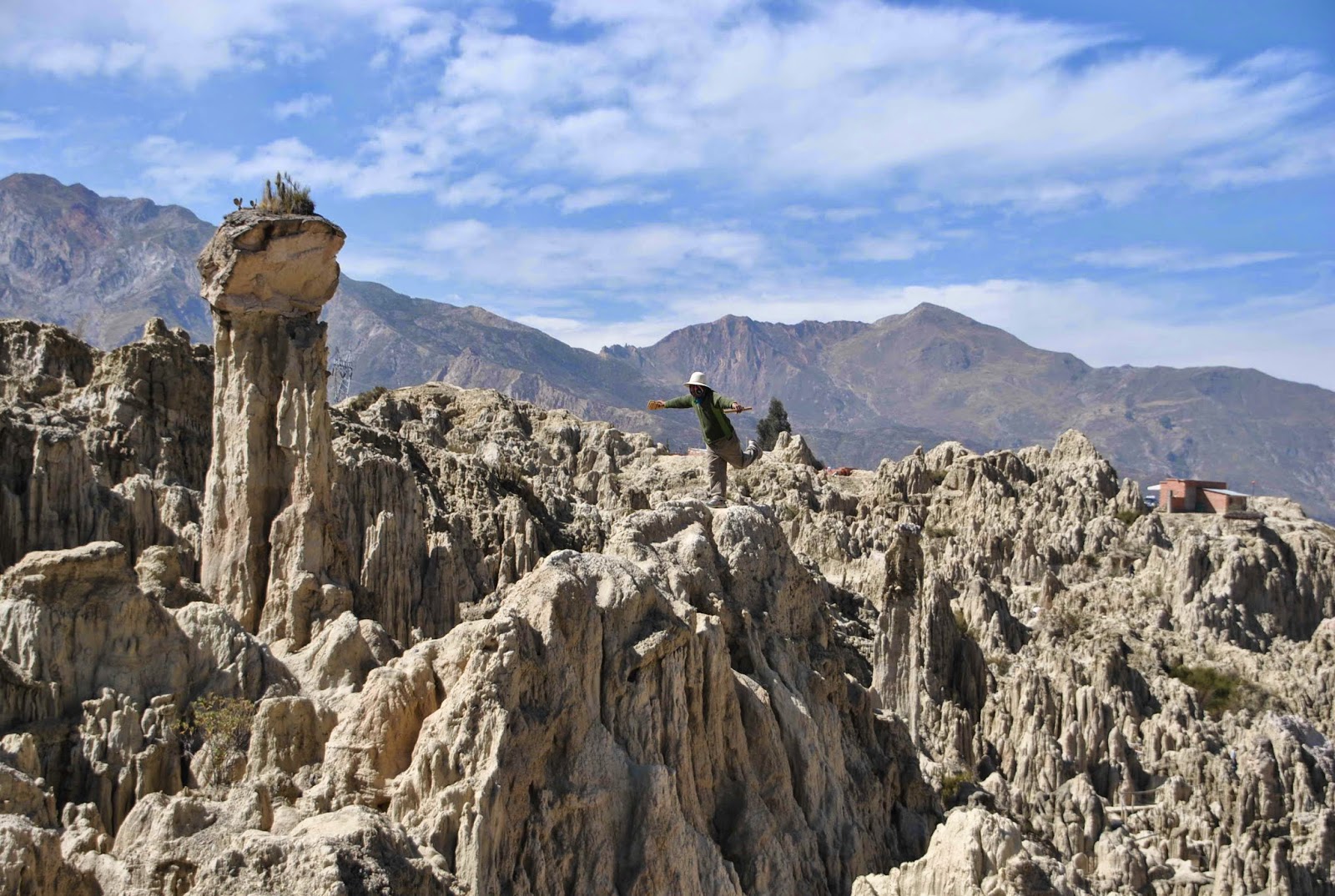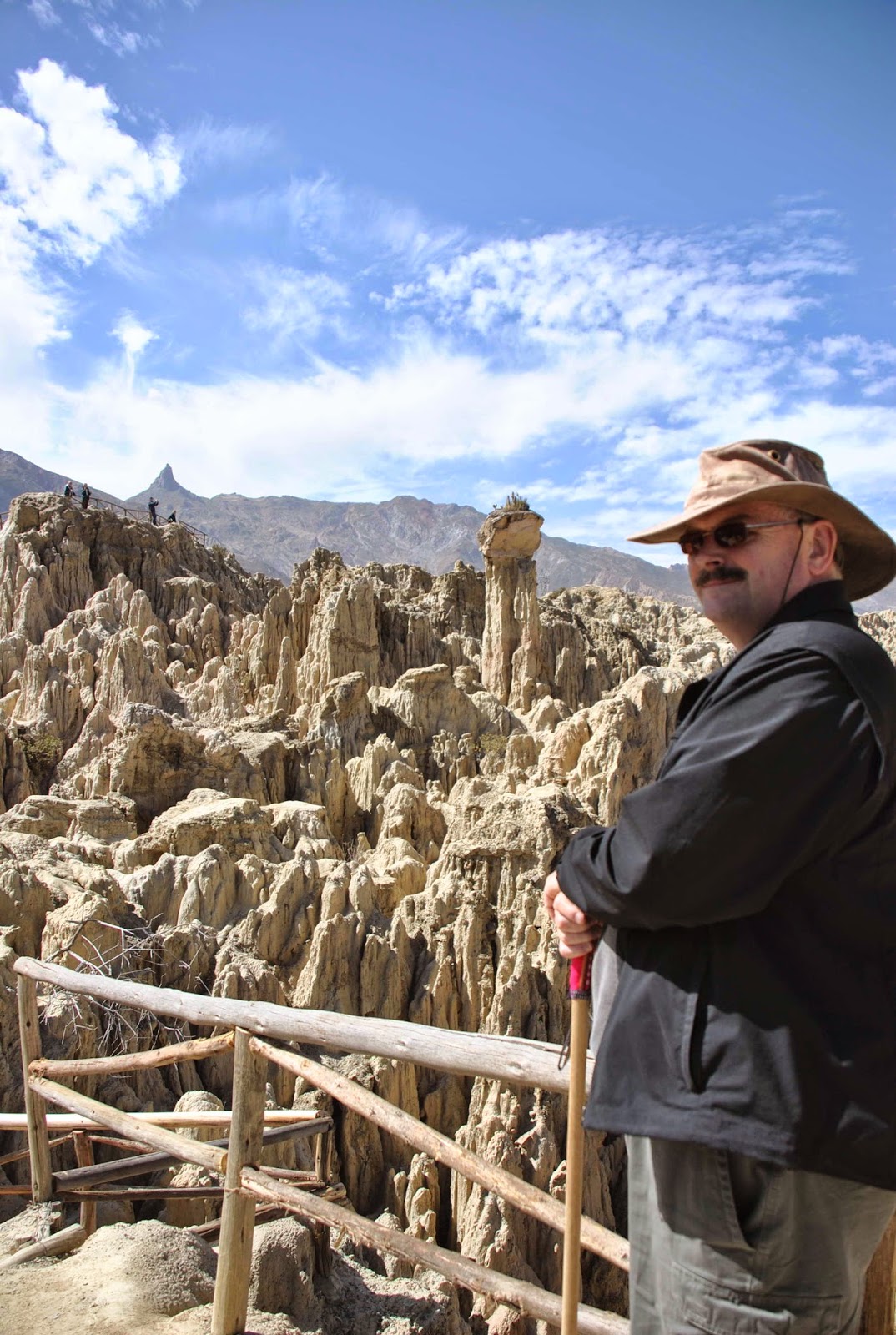Our last big travel day included in the tour - getting from
Puno to La Paz - turned out differently than every other one of Marcos's
Peru/Bolivia tours, and he's done more of them than anyone else.
A few days earlier, Marcos had hinted that there might be a
logistical issue with the trip, but not to worry, he was working on an
alternative routing. Once he got the details confirmed, he told us what was
going on. Thursday was the Feast of Corpus Christi, a national holiday in Peru
just as it is in many largely Catholic cities and/or states; Saturday would be
June 21, the Winter Solstice, and a holiday for the Quechua and Aymara people,
so somebody had to come up with a reason for a three-day holiday. Apparently
some groups in Juli, where we were to pick up our hydrofoil ride, had decided
to stage a protest to do with mining, which is very big in southern Peru. It
wasn't necessarily a sure thing that they'd disrupt our bus ride, but it never
hurts to have a Plan B. So Marcos had come up with one. It was later proven to be a good idea, as the road was in fact blocked for a couple of hours.
Rather than a bus ride to Juli and then taking the hydrofoil
around part of the lake to Sun Island, Bolivia, and then on to Huatajata where we would meet
the bus to La Paz, Marcos had arranged for us to take a hydrofoil ALL THE WAY
from Puno. Even the locals don't usually do this, so we had an extra special
trip.
So we climbed aboard a boat similar to the one we had toured
on yesterday and chugged slowly across the end of the bay, not even reaching
Puno. We rafted onto the hydrofoil (our luggage was all stored and tarped on
top) and everyone transferred boats. Then we set out, past the totora reeds and
into the main part of the lake. The trip to Sun Island took about 2 hours even
though we were travelling at 25 knots or so, a little choppy but not too bad,
much like Lake Simcoe on a nice summer day.
Sun Island is the largest island in Lake Titicaca, located
in the Bolivian side. It is said that Sun Island is THE origin of the Inca, the
place from where Inti, the Sun, sent his son Manco Capac, and his daughter Mama
Ocllo, to create a kingdom to rule the people. They eventually settled in Cusco
and established the Inca empire with Manco Capac as the first Inca.
 |
| On the water |
 |
| Looks sort of like the islands in Georgian Bay |
 |
| No, those are NOT clouds. That's a mountain range in Bolivia |
 |
| View from our lunch spot |
 |
| Our hydrofoil |
After yet another climb (we were getting really good use of
those walking sticks) we were rewarded with an outdoor lunch.
 |
| Pasta Potato Veggie Soup - delicious! |
 |
| Main course, including white corn, potato, trout and a quinoa pancake |
 |
| With some of our fellow travelers |
We weren't bereft of wildlife here, either. Two of the
locals -
 |
| These two are owned by the people who have the house/restaurant where we had lunch. Some of the very few cats we saw on this trip |
As well, we caught a glimpse of the world's biggest
hummingbird. We had heard that the largest one is about 5 inches from head to
tail and couldn't quite fathom one that size. We were all enjoying dessert when
all of a sudden, Marcos jumped to his feet and started pointing and shouting,
'There it is! The biggest hummingbird!!' Apparently the colourful tops of our
walking sticks had attracted it, but not long enough for anyone to be able to
get a picture. It certainly was huge!
Once back on the hydrofoil we had another 90 minutes before
we reached Huatajata and another brief stop to visit the Limachi family. Not
exactly a household name, unless you happen to belong to the Heyerdahl
household - as in Thor Heyerdahl who sailed the Kon-Tiki and the Ra II across
the Atlantic and Pacific Oceans in the 1970s. The boats were built by the
Limachi family, right here on Lake Titicaca. They have a replica of the Ra II
in their small museum.
 |
| One of the Msrs. Limachi paddling out to meet us |
 |
| The Ra II. Hard to imagine this boat sailing all the way across Lake Titicaca, never mind an ocean! |
 |
| Part of the herd. We still have trouble telling the llamas from the alpacas! |
Then we were on the way to La Paz. On the way we learned
about the history and economy of Bolivia and how it has been changing in the
past ten or so years. Despite the improvements being made, over 70% of the
economy is of the black market kind, since many people live in rural areas and
trade locally, not so much avoiding taxes as living outside of the organized
economy of the big cities.
 |
| Rural living in Bolivia |
 |
| A small 'storefront' in one of the outlying towns |
We were in for yet another surprise when we arrived at La
Paz, or should we say to El Alto, the 'suburb' where the airport is located.
This is what La Paz looks like from there:
Yes, that is a cable car, and yes, the city looks really,
really far down in that valley. Some believe that the valley is actually the
crater of an extinct volcano, and it is really easy to agree with that
assessment. From where we were standing, downtown La Paz was about 2,000 feet
below us. The cable cars are a recent innovation, cutting travel time from
areas like El Alto to downtown from an hour and a half to 8 minutes! There are
two more cable car lines being built to further reduce traffic congestion from other areas. And
they could certainly use the help!!
After settling in with the first night in our hotel, on
Saturday we headed out for a city tour.
 |
| The Bolivian State Building |
 |
| The cathedral. They had just been celebrating the anniversary of the Bolivian Police with a service inside. Don't think we could have been any safer! |
 |
| In the plaza (Gustavo said, if you don't like pigeons, don't go there), a woman and her daughter feeding the birds |
 |
| Some of the colonial architecture |
 |
| Should we use knitting needles or a crochet hook??? We have no idea how they keep track of all of these wires! |
We next visited the Witches' Market, so called because many
of the stall and shop-owners were women who sold herbal and natural remedies
for all sorts of ailments, and so were, of course, called witches. Nowadays
there are still some weird things being sold but many shops sell regular
products, textile and knitwear and souvenirs.
 |
| Herbs, teas and natural remedies |
 |
| Across the way, icons and statues |
 |
| Blankets, scarves, water bottle holders and even guitar cases! |
 |
| We stumbled into this little courtyard where we bought a couple of small souvenirs |
Our final daytime excursion visit - and the one where we
finally relinquished those walking sticks! - was to the Valley of the Moon, an
area still within the valley of La Paz.
 |
| Yes, he is standing up there on one foot! There are crazy people everywhere! |
We even caught a glimpse of the world's highest golf course.
The best photo we could get was a bit of fairway through the trees. At this
elevation, even Monica could hit a 300 yard drive, and Larry could hit
straight!
Finally, we had an impromptu concert by our local guide
Gustavo and the fellow who had been playing the panpipe up on that pedestal
when we arrived (who has very impressive balance!)
Our farewell dinner included a private tour of the Museum at
the Church of San Francisco and dinner at a local restaurant nearby. We
couldn't resist closing the blog with a wonderful photo of our fearless leader,
Marcos, in some authentic conquistador gear:
Some final observations on this amazing adventure: There are
sites in these countries that have to be seen to really be understood, and
Machu Picchu is one of them. Even after reading a number of books we weren't
prepared for the real thing. The environment in general is so completely
different than what we sea-level dwellers are used to that we never really got
used to it. Of course, having colds certainly didn't help much, but the thin
air and the extreme dryness started to affect almost everyone on the tour by
the last few days. Physiological issues notwithstanding, we visited places that
we didn't know existed, and discovered ways of life that have been perpetuated
for hundreds of years by people who are quite content to live with the
land, not just on it, using up its resources. The genuine welcome and
friendliness of all of these people is something we will not forget.
This has been a once in a lifetime trip, and we hope you
have enjoyed following our progress.







































